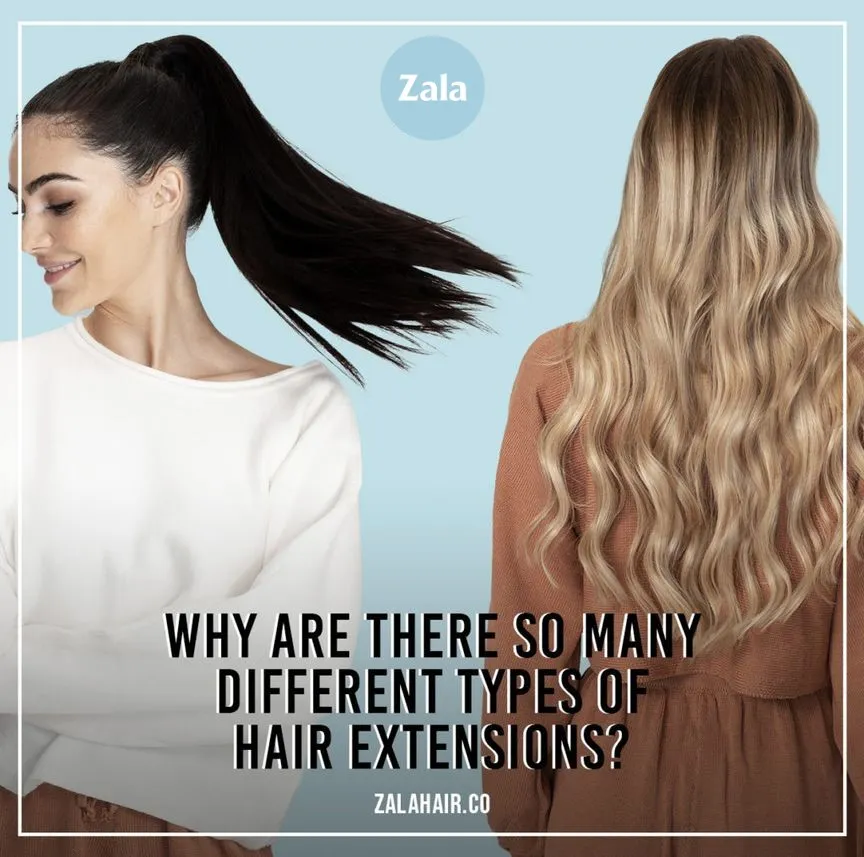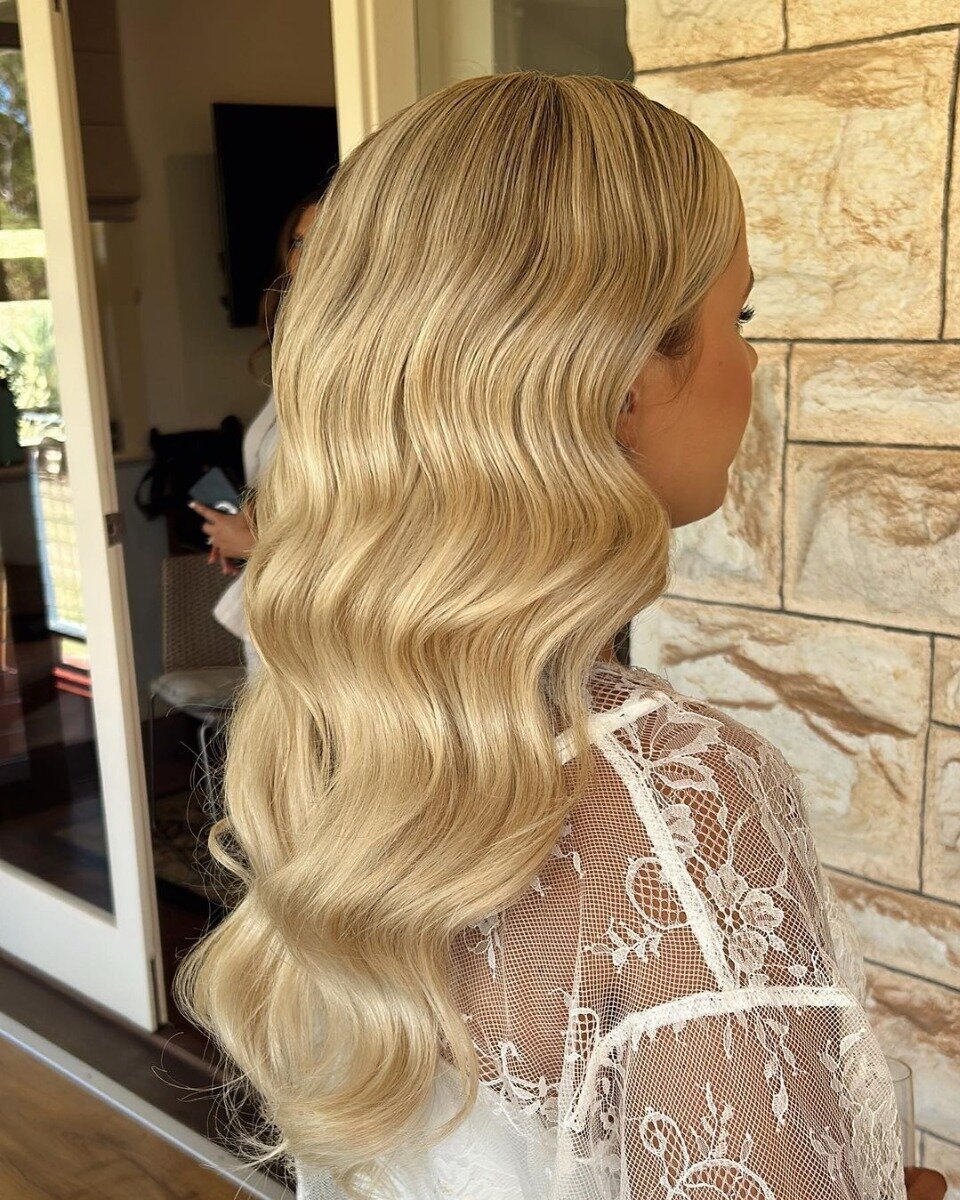Why Are There So Many Different Types Of Hair Extensions?
Choosing the right hair extensions for you can be quite difficult, especially if you consider how many different types of hair extensions are out on the market today.
In this article, we’ll answer the common question: What are the different kinds of hair extensions?

Why Are There So Many Hair Extension Types?
What type of hair extensions are there, and why are there so many? The answers are fairly simple.
Some people want extensions that will last in their hair for a longer time. Others want extensions that they can install and remove any time they want. Some prioritize the cost of the extensions over everything else. Others don’t care how much they’re paying as long as they get the highest quality products. Some only want extensions that aren’t hard to maintain. Others are more open to high-maintenance options.
In other words, different people have different needs and preferences. And when you’re looking for the right type of hair extensions for you, it’s your personal preferences that you need to assess first.
This article will guide you through the different types of human hair extensions. These are typically categorized into three categories:
- based on usage;
- based on the method of application;
- and based on material.
Types Of Hair Extensions Based On Usage
1. Temporary Hair Extensions
Temporary hair extensions are called such because they have to be removed before you go to bed every night. Over the years, they have become a very popular type of hair extension, mainly due to the fact that they’re so easy to attach and remove. Since temporary hair extensions require no skill to install, they’re also perfect for people on a budget who may not be ready to pay for the service at a salon.
However, one downside of temporary hair extensions is that the frequent act of removing and reapplying can cause breakages, especially if you use low-quality extensions. The most common subtypes of temporary hair extensions include clip-ins, halos, and ponytail hair extensions.
2. Semi-Permanent Hair Extensions
Semi-permanent hair extensions are ones that are meant to stay in your hair for a longer period of time. For people who are always busy, this type of extension is preferable because they don’t have to set aside a portion of their day to apply the extensions to their hair.
These extensions are not technically permanent, but they do last for a while, hence why they’re called semi-permanent. For most people, they should stay for at least four to eight weeks, though the exact duration still depends on the individual person, the type of hair extensions, the way they’re cared for and looked after, as well as the quality of the extensions.
Typically, semi-permanent hair extensions are attached by professionals in salons, although some people also opt to do it themselves. Some examples of permanent hair extensions include tape-ins, fusions, wefts, microlinks and weave-ins.
Types Of Hair Extensions Based On Method Of Application
1. Clip-In Hair Extensions
Clip-in hair extensions are arguably the most popular type of temporary hair extensions in the world.
They’re the easiest type of hair extensions to apply to one’s hair, even if you’re a complete beginner. They are extremely versatile and can be used in a variety of ways.
If you don’t think you’ll be using hair extensions every day, clip-ins are a great choice. They don’t typically cost as much as other types of extensions which makes them perfect for those on a budget. That said, clip-ins aren’t recommended for thin-haired people, because thin hair may not be enough to be able to hide them from plain view.
2. Halo Hair Extensions
Halo hair extensions are a great choice for those who are in a hurry. If you’re usually running late for work, then replacing multi-piece hair extension sets with the one-piece halo hair extension may reduce the time it takes you to get ready every morning.
In addition to this, halos are the least damaging of all hair extension types. That’s because halos aren’t really attached to your actual hair, so there’s no chance of them accidentally pulling or tugging on your strands.
3. Ponytail Hair Extensions
Do you like putting your hair in a ponytail? If so, you should try out ponytail hair extensions. These extensions were made to wrap or clip around your actual ponytail, in order to give your crowning glory more length and volume.
Like the halos, there’s also no danger of your hair getting damaged by ponytail extensions, as these don’t attach to the actual strands. Compared to clip-ins, they don’t take very long to apply, although halos are still a quicker option.
4. Tape-In Hair Extensions
If you have fine or thin hair, you’d definitely love tape-in hair extensions. The tapes are small in size which makes them quite unnoticeable. This means you don’t need to have thick hair in order to hide them from sight.
For the best results, we suggest that you go to your favorite salon in order to have your tape-ins installed. They normally have to be moved up every 6-8 weeks, depending on the quality of the extensions and how fast your hair is growing.
Tape-ins tend to have more downsides than other kinds of hair extensions. First of all, they are sometimes harder to deal with when you’re aiming for a specific hairstyle. For instance, having tape-in hair extensions can make it more difficult for someone to wear a high ponytail since the tape-ins can get in the way.
Secondly, tape-ins are harder to hide once your hair starts growing. After all, as your hair grows, the tape will start moving down your strands too. When this happens, you need to get it removed and reapplied, which can be damaging to your hair.
Third, maintenance can be pretty difficult. Since tape-ins are applied with an adhesive, your hairstylist will probably tell you to avoid using certain conditioners or oils. This is because of specific ingredients that may dissolve the glue used to tape the extensions to your hair.
5. Fusion Hair Extensions
Also known as pre-bonded hair, fusion hair extensions are a type of semi-permanent hair extension that is applied to your strands using heat and keratin glue. The process can take up to 5 hours in total since the adhesive has to be thoroughly dried first.
Keep in mind that once you get these extensions uninstalled from your hair, they can’t be reused anymore. So you’d have to buy new extensions every time you want them “reapplied”. Depending on how quickly your hair grows or how worn out your extensions are, this cycle can get really vicious, really quickly.
But if you love hair extensions, getting fusion hair extensions installed to your hair is something that you simply should do. Luckily, these babies can last up to 6 months if taken care of properly.
6. Weft Hair Extensions
Weft hair extensions, also called beaded weft extensions, are a semi-permanent type of hair extensions that are bonded to your hair using small beads with inner linings made of silicone. They last for about a month and are usually installed by professional hairstylists.
Thick-haired ladies will certainly appreciate these hair extensions. They’re much gentler on your strands as well, since there’s no adhesive used to attach them to the hair itself.
The only downside is that since they only last for 3-5 weeks, salon visits will be more frequent if you choose this type of extension.
7. Weave Hair Extensions
Also known as sew-in hair extensions, weave hair extensions are sewn into your natural hair. They’re popular for two reasons:
- they’re affordable and;
- when done right, they’re practically seamless.
That said, if you think your hair is too weak or fragile, don’t go for weave hair extensions. These can be quite heavy on your hair, so weaker strands will be more prone to getting damaged. They’re best fitted for those with thick strands who can withstand some amount of pulling.
Also, it’s best to have a professional hairstylist do this to your hair, as improper weaving can cause your roots to get pulled, therefore damaging your strands.
8. Microlink Hair Extensions
Microlink hair extensions, also known as micro loop or micro bead, are a type of hair extension that makes use of silicone-lined beads to insert wefts of hair extensions to your natural hair. The bead is then secured and tightened to prevent it, and the weft of hair it holds, from falling out.
Although microlinks aren’t attached to your natural hair with adhesives, they can also be quite damaging if applied improperly. For example, if the bead is too tight, it could pull on the roots and cause damage to your strands.
When done right, they can last up to four months in your hair, although they may have to be repositioned every other month. Those with thin hair should avoid them as the beads may be visible without thicker hair to cover them.
Types Of Hair Extensions Based On Material
1. Synthetic Hair
Synthetic hair extensions are made from fibers that were manufactured to resemble real human hair.
In terms of quality, synthetic hair extensions are not comparable to real human hair extensions. They used to be the default choice for people who wanted to stick to a budget.
2. Natural Hair
True to its name, natural hair extensions are made from real human hair. If you want hair extensions that look and feel exactly like your own hair. These types of hair extensions can be safely dyed, toned, and styled just like your own hair too.
Take note that while extensions made out of real human hair are of higher quality than synthetic hair, the degree of quality still varies from manufacturer to manufacturer.
The highest quality of human hair that you can find on the market right now is Remy hair, the same type of hair that our hair extensions at ZALA are made of. So if you’re looking for high-quality hair extensions, look no further than our own hair extensions here at ZALA.
As you can see, there are many different types of hair extensions to fit different types of people. What about you, which one is your favorite type of hair extensions? Let us know your thoughts in the comments below! And as always, for more hair tips and tricks, don’t forget to check out our ZALA blog!




